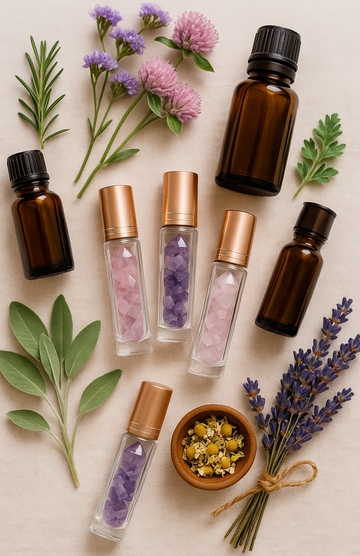There’s a moment in every aromatherapist’s journey where the work begins to shift. It doesn’t happen loudly. It’s rarely dramatic. It’s more like the soft awareness that, after blending for a while, you’re ready for something deeper. You know the basics, you trust your favourites, you’ve helped clients feel better… but your intuition starts nudging you toward the why behind the oils, the blends, and the results you’re achieving.
I remember that feeling beautifully, many years ago, standing over my blending table with lavender and clary sage open, believing the combination was perfect. And in many ways, it was. But when my client later mentioned a headache, I realised it wasn’t the oils that were “wrong,” but the level of understanding behind them. My blend was good — but it wasn’t clinical. And that subtle difference is what changed the entire direction of my career.
What I discovered in the decades that followed is that essential oils behave like personalities. Some are bright and volatile, some slow and grounding, some slip across the skin with ease, while others cling like syrup. They respond to the skin differently depending on where they’re applied. They interact with age, health conditions, metabolism, medication, and even emotional state. They vary in viscosity, absorption, drop rate, and pharmacology in ways that completely transform a blend — even when the recipe looks the same on paper.
It’s here, in these quiet details, that aromatherapy becomes not just a complementary therapy but a truly therapeutic art.
Most therapists begin with memorised percentages, and that’s a wonderful place to start — it’s exactly where we all begin. But the body doesn’t work in percentages. It works in context. A 2% dilution on the face behaves differently from a 2% dilution on the abdomen. A warm compress penetrates the skin differently from a lotion. An oil high in ketones behaves completely differently from one rich in monoterpenes, even at the same dilution. When you begin blending with these layers in mind, your practice becomes more intentional, more refined, and far more effective.
One area therapists often don’t think about — until their advanced studies — is cumulative exposure. You might create a calming rollerball, a soothing nighttime lotion, and a diffuser blend for rest… but the body doesn’t separate them. It experiences the total load. When you understand this, especially with oils that contain more stimulating or potent constituents, your blending becomes both safer and more therapeutic at the same time.
This deeper way of thinking is particularly important when working with children, elderly clients, or anyone navigating health conditions. Their skin, absorption rate, and liver metabolism are completely different. It isn’t about using “smaller doses” — it’s about creating entirely different blends that honour their physiology. When you blend this way, something shifts: your confidence grows, your intuition strengthens, and your treatments feel both gentle and powerful.
And then, of course, comes the moment almost every therapist reaches: when drops stop being enough. We love the ritual of them, but they’re notoriously inconsistent. Viscosity, temperature, and bottle shape can all change the size of a drop. When you begin blending by weight instead of drops, your formulas become repeatable, reliable, and genuinely professional. Your creativity becomes grounded in certainty. Your blends become your signature.
This deeper understanding doesn’t replace the intuitive beauty of aromatherapy — it enriches it. It gives you the confidence to blend with intention rather than guesswork, and it elevates your treatments from “lovely” to deeply therapeutic. Many therapists don’t realise it, but when they reach this point — when the questions become more refined and the desire to expand skill becomes stronger — they’re ready for advanced study. They’re ready to grow into the next level of their professional identity.
This is precisely why The Morgan Academy exists.
Not to make you start again, but to help you build on the wisdom you already have.
To take what you know and deepen it.
To make the science feel friendly, accessible, and empowering.
To strengthen your confidence and precision without losing the heart of your work.
Time and time again, therapists come to me expecting recipes and techniques — and they receive those, of course — but what they gain is far more valuable. They learn to think clinically, creatively, and holistically. They begin to understand essential oils not only by their names, but by their chemistry, their behaviour, and their relationship with the human body. And in that moment, something remarkable happens: their work transforms.
If you felt something stirring while reading this — a spark of curiosity, a sense that you’re ready to refine your skills, or the quiet realisation that you’d like to blend with more intention and confidence — then you’re already on the path toward your next chapter. And I would love to guide you th
I have more than 45 years of hands-on experience in essential oil therapy, clinical aromatherapy, formulation, and holistic practice, I’ve dedicated my career to helping therapists discover the deeper layers of this beautiful discipline. My work began long before essential oils became mainstream, shaped by traditional clinical studies, a lifelong fascination with plant medicine, and a deep appreciation for the art–and the science–behind therapeutic blending.
My passion has always been to teach in a way that feels warm, accessible, and rooted in decades of real-world practice. The Morgan Academy grew from this passion — a place where therapists can expand their knowledge, refine their skills, and gain the clinical confidence that transforms both their treatments and their career. It brings me joy every day to support practitioners who are ready to take their understanding further and discover what they’re truly capable of.







